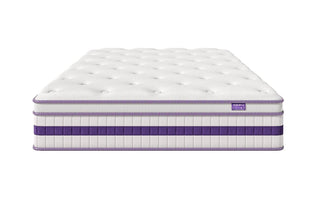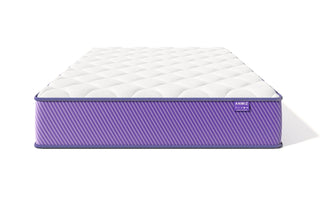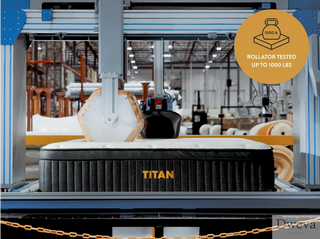As the world of sleep products continues to evolve, natural latex mattresses have become increasingly popular for their unique blend of comfort and eco-friendly appeal. Made from the sap of rubber trees, these mattresses offer a sustainable option for those seeking a comfortable and environmentally-conscious sleep surface. With more consumers prioritizing both their health and the planet, understanding natural latex mattresses has become more important than ever.
In this guide, we’ll dive into what natural latex mattresses are, how they’re made, and why they’ve become such a popular choice for modern sleepers.
What Are Natural Latex Mattresses?
Natural latex mattresses are made from the sap of rubber trees, which is then processed into a foam-like substance to create the mattress. This material is a great choice for those seeking an eco-friendly and durable option for their bedding.
Mattresses made from organically farmed latex are often considered some of the best organic mattresses on the market. When you sleep on one of these, you avoid exposure to harmful chemicals, making them a healthier choice for both you and the environment.
Natural vs. Synthetic Latex
The key difference between natural latex and synthetic latex lies in their composition. Natural latex is derived from the sap of rubber trees, while synthetic latex is made from petroleum-based polymers. Naturally, the quality, durability, and eco-friendliness of natural latex far exceed that of its synthetic counterpart.
Are Natural Latex Mattresses Organic and Eco-Friendly?
Not all natural latex mattresses are organic, as organic materials are defined by the specific farming practices used. Organic natural latex is produced without harmful chemicals, but some natural latex mattresses may still be made using synthetic chemicals during the manufacturing process.
To ensure that a mattress is truly organic, check for certifications like GOLS (Global Organic Latex Standard) or GOTS (Global Organic Textile Standard).
How Is Natural Latex Made?
The production of natural latex begins with tapping rubber trees to collect their sap. Ammonia is added to prevent the sap from solidifying. After enough sap is collected, an acid is introduced to cause coagulation, turning the sap into rubber.
To process the latex, excess water is removed by passing the rubber sheets through rollers before they are hung to dry. Afterward, the rubber is processed to create latex foam, which is then used to make mattresses.
Pros and Cons of Natural Latex Mattresses
Pros
- Durable: Latex mattresses are known for their longevity and can last up to 20 years with proper care.
- Comfortable: The natural elasticity of latex offers a supportive yet comfortable sleep surface.
- Antimicrobial: Latex naturally resists mildew, mold, and dust mites, making it an excellent choice for people with allergies.
- Breathable and Cooling: The open-cell structure of latex helps with air circulation, keeping the mattress cool.
- Easy to Clean: Latex mattresses are relatively easy to clean and maintain.
- Allergen-Free: Many latex mattresses are hypoallergenic and free from harmful chemicals.
Cons
- Expensive: Due to the labor-intensive production process and quality of materials, latex mattresses can be more costly than other types.
- Heavy and Difficult to Move: Latex mattresses are typically heavier than regular mattresses, making them challenging to move.
- Initial Off-Gassing Smell: Some latex mattresses may have a rubbery smell when first unpacked, though it usually dissipates in a few days.
Common Complaints About Latex Mattresses
If you’re considering investing in a latex mattress, be aware of these common complaints:
Bounce and Motion Transfer
Latex mattresses tend to have more bounce than memory foam. While this can be a positive for some, it may not be ideal for couples who prefer motion isolation. If you’re looking for a mattress that minimizes movement transfer, check out our best mattresses for couples.
Heavy Weight
Latex mattresses are heavier than most, making them harder to move around. This may be something to consider if you plan on frequently relocating your mattress.
Cost
Natural latex mattresses are often on the pricier side. While they’re an investment in longevity and quality, they may not fit every budget. However, considering their durability, they might be worth the investment.
Why Are Natural Latex Mattresses So Expensive?
The high cost of natural latex mattresses is partly due to the high demand for rubber trees in various industries. The harvesting process is labor-intensive, and the eco-friendly nature of the material also contributes to the higher price point.
Off-Gassing
When new latex mattresses are first unpacked, they may emit an off-gassing smell. This is caused by volatile organic compounds (VOCs) being released. The smell typically fades within a few days, but you can speed up the process by airing out the mattress in a well-ventilated room.
How to Clean and Care for Natural Latex Mattresses
To clean your latex mattress, gently wash it with water and mild soap. Afterward, dab it with a cloth to absorb excess moisture, then let it air dry. Be sure to avoid direct sunlight during the drying process to prevent damage.
What to Look for When Buying a Natural Latex Mattress
When shopping for a natural latex mattress, here are some important factors to consider:
Quality Materials
Ensure the latex is produced from organically farmed rubber trees for the best quality and sustainability. Look for certifications such as GOLS or GOTS to confirm that the mattress meets organic standards.
Cost
Although latex mattresses tend to be more expensive, comparing your options can help you find the best deal for the quality you want. Don’t forget to factor in the mattress’s longevity when considering the price.
Firmness
Latex mattresses generally feel firmer, but you can find options with a softer feel if that’s what you prefer. Be sure to choose one that suits your sleep style.
Pressure Relief
Look for a mattress that evenly disperses your weight to provide adequate pressure relief, especially if you’re a side sleeper who feels pressure on the hips or shoulders.
Durability
One of the key advantages of natural latex mattresses is their durability. They tend to last longer than memory foam or innerspring mattresses, making them a worthwhile investment for those seeking a long-term solution.
Cooling
If you sleep hot, consider a natural latex mattress for its breathability. Latex’s natural ability to regulate temperature makes it a great option for hot sleepers.
FAQs
Are natural latex mattresses safe for those with allergies?
Yes! Natural latex mattresses are hypoallergenic and resistant to common allergens like dust mites, mold, and mildew, making them a great choice for allergy sufferers.
How long do natural latex mattresses last?
With proper care, natural latex mattresses can last anywhere from 10 to 20 years, depending on the quality of materials and maintenance.
Are natural latex mattresses hot?
No, natural latex mattresses are naturally cooling. They allow air to flow through, making them a great option for those who tend to sleep hot.







 https://dweva.com
https://dweva.com























